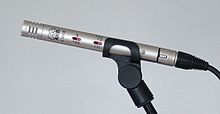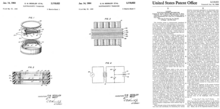The condenser microphone, invented at Bell Labs in 1916 by E. C. Wente[17] is also called a capacitor microphone or electrostatic microphone—capacitors were historically called condensers. Here, the diaphragm acts as one plate of a capacitor, and the vibrations produce changes in the distance between the plates. There are two types, depending on the method of extracting the audio signal from the transducer: DC-biased microphones, and radio frequency (RF) or high frequency (HF) condenser microphones. With a DC-biased microphone, the plates are biased with a fixed charge (Q). The voltage maintained across the capacitor plates changes with the vibrations in the air, according to the capacitance equation (C = Q⁄V), where Q = charge in coulombs, C = capacitance in farads and V = potential difference in volts. The capacitance of the plates is inversely proportional to the distance between them for a parallel-plate capacitor. (See capacitance for details.) The assembly of fixed and movable plates is called an "element" or "capsule".
A nearly constant charge is maintained on the capacitor. As the capacitance changes, the charge across the capacitor does change very slightly, but at audible frequencies it is sensibly constant. The capacitance of the capsule (around 5 to 100 pF) and the value of the bias resistor (100 MΩ to tens of GΩ) form a filter that is high-pass for the audio signal, and low-pass for the bias voltage. Note that the time constant of an RC circuit equals the product of the resistance and capacitance.
Within the time-frame of the capacitance change (as much as 50 ms at 20 Hz audio signal), the charge is practically constant and the voltage across the capacitor changes instantaneously to reflect the change in capacitance. The voltage across the capacitor varies above and below the bias voltage. The voltage difference between the bias and the capacitor is seen across the series resistor. The voltage across the resistor is amplified for performance or recording. In most cases, the electronics in the microphone itself contribute no voltage gain as the voltage differential is quite significant, up to several volts for high sound levels. Since this is a very high impedance circuit, current gain only is usually needed, with the voltage remaining constant.
RF condenser microphones use a comparatively low RF voltage, generated by a low-noise oscillator. The signal from the oscillator may either be amplitude modulated by the capacitance changes produced by the sound waves moving the capsule diaphragm, or the capsule may be part of a resonant circuit that modulates the frequency of the oscillator signal. Demodulation yields a low-noise audio frequency signal with a very low source impedance. The absence of a high bias voltage permits the use of a diaphragm with looser tension, which may be used to achieve wider frequency response due to higher compliance. The RF biasing process results in a lower electrical impedance capsule, a useful by-product of which is that RF condenser microphones can be operated in damp weather conditions that could create problems in DC-biased microphones with contaminated insulating surfaces. The Sennheiser "MKH" series of microphones use the RF biasing technique.
Condenser microphones span the range from telephone transmitters through inexpensive karaoke microphones to high-fidelity recording microphones. They generally produce a high-quality audio signal and are now the popular choice in laboratory and recording studio applications. The inherent suitability of this technology is due to the very small mass that must be moved by the incident sound wave, unlike other microphone types that require the sound wave to do more work. They require a power source, provided either via microphone inputs on equipment as phantom power or from a small battery. Power is necessary for establishing the capacitor plate voltage, and is also needed to power the microphone electronics (impedance conversion in the case of electret and DC-polarized microphones, demodulation or detection in the case of RF/HF microphones). Condenser microphones are also available with two diaphragms that can be electrically connected to provide a range of polar patterns (see below), such as cardioid, omnidirectional, and figure-eight. It is also possible to vary the pattern continuously with some microphones, for example the Røde NT2000 or CAD M179.
A valve microphone is a condenser microphone that uses a vacuum tube (valve) amplifier.[18] They remain popular with enthusiasts of tube sound.
Electret condenser microphone
An electret microphone is a type of capacitor microphone invented by Gerhard Sessler and Jim West at Bell laboratories in 1962.[19] The externally applied charge described above under condenser microphones is replaced by a permanent charge in an electret material. An electret is a ferroelectric material that has been permanently electrically charged or polarized. The name comes from electrostatic and magnet; a static charge is embedded in an electret by alignment of the static charges in the material, much the way a magnet is made by aligning the magnetic domains in a piece of iron.
Due to their good performance and ease of manufacture, hence low cost, the vast majority of microphones made today are electret microphones; a semiconductor manufacturer[20] estimates annual production at over one billion units. Nearly all cell-phone, computer, PDA and headset microphones are electret types. They are used in many applications, from high-quality recording and lavalier use to built-in microphones in small sound recording devices and telephones. Though electret microphones were once considered low quality, the best ones can now rival traditional condenser microphones in every respect and can even offer the long-term stability and ultra-flat response needed for a measurement microphone. Unlike other capacitor microphones, they require no polarizing voltage, but often contain an integrated preamplifier that does require power (often incorrectly called polarizing power or bias). This preamplifier is frequently phantom powered in sound reinforcement and studio applications. Monophonic microphones designed for personal computer (PC) use, sometimes called multimedia microphones, use a 3.5 mm plug as usually used, without power, for stereo; the ring, instead of carrying the signal for a second channel, carries power via a resistor from (normally) a 5 V supply in the computer. Stereophonic microphones use the same connector; there is no obvious way to determine which standard is used by equipment and microphones.
Only the best electret microphones rival good DC-polarized units in terms of noise level and quality; electret microphones lend themselves to inexpensive mass-production, while inherently expensive non-electret condenser microphones are made to higher quality.
source: wikipedia


